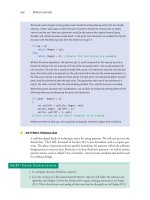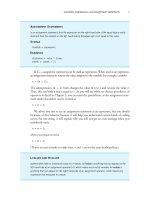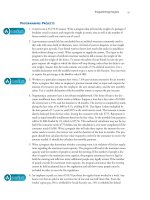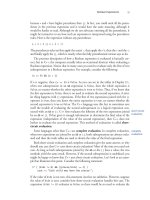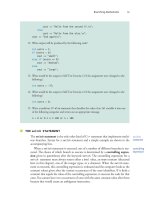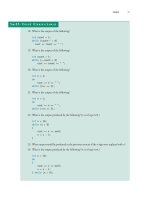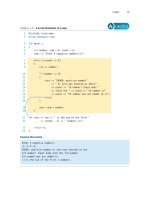Absolute C++ (4th Edition) part 57 pot
Bạn đang xem bản rút gọn của tài liệu. Xem và tải ngay bản đầy đủ của tài liệu tại đây (143.39 KB, 10 trang )
Thinking Recursively 567
is that the chain of recursive calls will always reach a stopping case and that the stop-
ping case always returns the correct value.
When designing a recursive function, you need not trace out the entire sequence of
recursive calls for the instances of that function in your program. If the function
returns a value, all you need do is check that the following three properties are satisfied:
1. There is no infinite recursion. (A recursive call may lead to another recursive call and
that may lead to another, and so forth, but every such chain of recursive calls even-
tually reaches a stopping case.)
2. Each stopping case returns the correct value for that case.
3. For the cases that involve recursion: If all recursive calls return the correct value, then
the final value returned by the function is the correct value.
For example, consider the function
power in Display 13.3.
1. There is no infinite recursion: The second argument to
power(x, n) is decreased by 1
in each recursive call, so any chain of recursive calls must eventually reach the case
power(x, 0), which is the stopping case. Thus, there is no infinite recursion.
2. Each stopping case returns the correct value for that case: The only stopping case is
power(x, 0). A call of the form power(x, 0) always returns 1, and the correct value
for x
0
is 1. So the stopping case returns the correct value.
3. For the cases that involve recursion: If all recursive calls return the correct value, then the
final value returned by the function is the correct value: The only case that involves
recursion is when
n > 1. When n > 1, power(x, n) returns
power(x, n - 1)*x
To see that this is the correct value to return, note that if power(x, n - 1) returns the
correct value, then
power(x, n - 1) returns x
n-1
and so power(x, n) returns
x
n−1
* x
which is x
n
, and that is the correct value for power(x, n).
That’s all you need to check to be sure that the definition of
power is correct. (The
above technique is known as mathematical induction, a concept that you may have
heard about in a mathematics class. However, you do not need to be familiar with the
term mathematical induction in order to use this technique.)
We gave you three criteria to use in checking the correctness of a recursive function
that returns a value. Basically the same rules can be applied to a recursive
void func-
tion. If you show that your recursive
void function definition satisfies the following
three criteria, then you will know that your
void function performs correctly:
1. There is no infinite recursion.
2. Each stopping case performs the correct action for that case.
3. For each of the cases that involve recursion: If all recursive calls perform their actions
correctly, then the entire case performs correctly.
criteria for
functions
that return
a value
criteria for
void
functions
568 Recursion
■
BINARY SEARCH
This subsection develops a recursive function that searches an array to determine
whether it contains a specified value. For example, the array may contain a list of num-
bers for credit cards that are no longer valid. A store clerk needs to search the list to see
if a customer’s card is valid or invalid.
The indexes of the array
a are the integers 0 through finalIndex. To make the task
of searching the array easier, we will assume that the array is sorted. Hence, we know
the following:
a[0] ≤ a[1] ≤ a[2] ≤ ≤ a[finalIndex]
When searching an array, you are likely to want to know both whether the value is
in the list and, if it is, where it is in the list. For example, if we are searching for a credit
card number, then the array index may serve as a record number. Another array
indexed by these same indexes may hold a phone number or other information to use
for reporting the suspicious card. Hence, if the sought-after value is in the array, we will
want our function to tell where that value is in the array.
Now let us proceed to produce an algorithm to solve this task. It will help to visual-
ize the problem in very concrete terms. Suppose the list of numbers is so long that it
takes a book to list them all. This is in fact how invalid credit card numbers are distrib-
uted to stores that do not have access to computers. If you are a clerk and are handed a
credit card, you must check to see if it is on the list and hence invalid. How would you
proceed? Open the book to the middle and see if the number is there. If it is not and it
is smaller than the middle number, then work backward toward the beginning of the
book. If the number is larger than the middle number, work your way toward the end
of the book. This idea produces our first draft of an algorithm:
found = false;//so far.
mid =
approximate midpoint between 0 and finalIndex;
if (key == a[mid])
{
found = true;
location = mid;
}
else if (key < a[mid])
search a[0] through a[mid - 1];
else if (key > a[mid])
search a[mid + 1] through a[finalIndex];
Since the searchings of the shorter lists are smaller versions of the very task we are
designing the algorithm to perform, this algorithm naturally lends itself to the use of
recursion. The smaller lists can be searched with recursive calls to the algorithm itself.
algorithm—
first version
Thinking Recursively 569
Our pseudocode is a bit too imprecise to be easily translated into C++ code. The
problem has to do with the recursive calls. There are two recursive calls shown:
search a[0] through a[mid - 1];
and
search a[mid + 1] through a[finalIndex];
To implement these recursive calls we need two more parameters. A recursive call
specifies that a subrange of the array is to be searched. In one case it is the elements
indexed by
0 through mid - 1. In the other case it is the elements indexed by mid + 1
through finalIndex. The two extra parameters will specify the first and last indexes of
the search, so we will call them
first and last. Using these parameters for the lowest
and highest indexes, instead of
0 and finalIndex, we can express the pseudocode more
precisely, as follows:
To search a[first] through a[last] do the following:
found = false;//so far.
mid =
approximate midpoint between first and last;
if (key == a[mid])
{
found = true;
location = mid;
}
else if (key < a[mid])
search a[first] through a[mid - 1];
else if (key > a[mid])
search a[mid + 1] through a[last];
To search the entire array, the algorithm would be executed with first set equal to 0
and last set equal to finalIndex. The recursive calls will use other values for first
and last. For example, the first recursive call would set first equal to 0 and last
equal to the calculated value mid - 1.
As with any recursive algorithm, we must ensure that our algorithm ends rather
than producing infinite recursion. If the sought-after number is found on the list, then
there is no recursive call and the process terminates, but we need some way to detect
when the number is not on the list. On each recursive call the value of
first is
increased or the value of
last is decreased. If they ever pass each other and first actu-
ally becomes larger than
last, we will know that there are no more indexes left to check
and that the number
key is not in the array. If we add this test to our pseudocode, we
obtain a complete solution, as shown in Display 13.5.
algorithm—
first
refinement
stopping
case
algorithm—
final version
570 Recursion
CODING
Now we can routinely translate the pseudocode into C++ code. The result is shown in
Display 13.6. The function
search is an implementation of the recursive algorithm
given in Display 13.5. A diagram of how the function performs on a sample array is
given in Display 13.7.
Notice that the function
search solves a more general problem than the original
task. Our goal was to design a function to search an entire array, yet the
search func-
tion will let us search any interval of the array by specifying the index bounds
first
and last. This is common when designing recursive functions. Frequently, it is neces-
sary to solve a more general problem in order to be able to express the recursive algo-
rithm. In this case, we only wanted the answer in the case where
first and last are set
equal to
0 and finalIndex. However, the recursive calls will set them to values other
than
0 and finalIndex.
Display 13.5 Pseudocode for Binary Search
int a[
Some_Size_Value
];
A
LGORITHM
TO
S
EARCH
a[first]
THROUGH
a[last]
//Precondition:
//a[first]<= a[first + 1] <= a[first + 2] <= <= a[last]
T
O
LOCATE
THE
VALUE
KEY
:
if (first > last) //A stopping case
found = false;
else
{
mid =
approximate midpoint between first and last;
if (key == a[mid]) //A stopping case
{
found = false;
location = mid;
}
else if key < a[mid] //A case with recursion
search a[first] through a[mid - 1];
else if key > a[mid] //A case with recursion
search a[mid + 1] through a[last];
}
Thinking Recursively 571
Display 13.6 Recursive Function for Binary Search
(part 1 of 2)
1 //Program to demonstrate the recursive function for binary search.
2 #include <iostream>
3 using std::cin;
4 using std::cout;
5 using std::endl;
6 const int ARRAY_SIZE = 10;
7 void search(const int a[], int first, int last,
8 int key, bool& found, int& location);
9 //Precondition: a[first] through a[last] are sorted in increasing order.
10 //Postcondition: if key is not one of the values a[first] through a[last],
11 //then found == false; otherwise, a[location] == key and found == true.
12 int main( )
13 {
14 int a[ARRAY_SIZE];
15 const int finalIndex = ARRAY_SIZE - 1;
<
This portion of the program contains some code to fill and sort
the array
a. The exact details are irrelevant to this example.
>
16 int key, location;
17 bool found;
18 cout << "Enter number to be located: ";
19 cin >> key;
20 search(a, 0, finalIndex, key, found, location);
21 if (found)
22 cout << key << " is in index location "
23 << location << endl;
24 else
25 cout << key << " is not in the array." << endl;
26 return 0;
27 }
28 void search(const int a[], int first, int last,
29 int key, bool& found, int& location)
30 {
31 int mid;
32 if (first > last)
33 {
34 found = false;
35 }
572 Recursion
CHECKING THE RECURSION
The subsection entitled “Recursive Design Techniques” gave three criteria that you
should check to ensure that a recursive
void function definition is correct. Let’s check
these three things for the function
search given in Display 13.6.
1. There is no infinite recursion: On each recursive call the value of
first is increased or
the value of
last is decreased. If the chain of recursive calls does not end in some
other way, then eventually the function will be called with
first larger than last,
which is a stopping case.
2. Each stopping case performs the correct action for that case: There are two stopping
cases, when
first > last and when key == a[mid]. Let’s consider each case.
If
first > last, there are no array elements between a[first] and a[last] and so
key is not in this segment of the array. (Nothing is in this segment of the array!) So,
if
first > last, the function search correctly sets found equal to false.
If
key == a[mid], the algorithm correctly sets found equal to true and location
equal to
mid. Thus, both stopping cases are correct.
3. For each of the cases that involve recursion, if all recursive calls perform their actions cor-
rectly, then the entire case performs correctly: There are two cases in which there are
recursive calls, when
key < a[mid] and when key > a[mid]. We need to check each of
these two cases.
First suppose
key < a[mid]. In this case, since the array is sorted, we know that if key
is anywhere in the array, then
key is one of the elements a[first] through a[mid - 1].
Display 13.6 Recursive Function for Binary Search
(part 2 of 2)
36 else
37 {
38 mid = (first + last)/2;
39 if (key == a[mid])
40 {
41 found = true;
42 location = mid;
43 }
44 else if (key < a[mid])
45 {
46 search(a, first, mid - 1, key, found, location);
47 }
48 else if (key > a[mid])
49 {
50 search(a, mid + 1, last, key, found, location);
51 }
52 }
53 }
Thinking Recursively 573
Display 13.7 Execution of the Function search
key
is 63
a[0] 15
a[1] 20
a[2] 35
a[3] 41
a[4] 57
a[5] 63
a[6] 75
a[7] 80
a[8] 85
a[9] 90
a[0] 15
a[1] 20
a[2] 35
a[3] 41
a[4] 57
a[5] 63
a[6] 75
a[7] 80
a[8] 85
a[9] 90
a[0] 15
a[1] 20
a[2] 35
a[3] 41
a[4] 57
a[5] 63
a[6] 75
a[7] 80
a[8] 85
a[9] 90
first == 0
mid = (0 + 9)/2
last == 9
mid = (5 + 9)/2
first == 5
last == 9
last == 6
mid = (5 + 6)/2
which is
5
a[mid]
is
a[5] == 63
found = TRUE;
location = mid;
first == 5
next
next
Not in
this half
Not here
574 Recursion
Thus, the function need only search these elements, which is exactly what the recur-
sive call
search(a, first, mid - 1, key, found, location);
does. So if the recursive call is correct, then the entire action is correct.
Next, suppose
key > a[mid]. In this case, since the array is sorted, we know that if
key is anywhere in the array, then key is one of the elements a[mid + 1] through
a[last]. Thus, the function need only search these elements, which is exactly what
the recursive call
search(a, mid + 1, last, key, found, location);
does. So if the recursive call is correct, then the entire action is correct. Thus, in both
cases the function performs the correct action (assuming that the recursive calls per-
form the correct action).
The function
search passes all three of our tests, so it is a good recursive function
definition.
EFFICIENCY
The binary search algorithm is extremely fast compared with an algorithm that simply
tries all array elements in order. In the binary search, you eliminate about half the array
from consideration right at the start. You then eliminate a quarter, then an eighth of
the array, and so forth. These savings add up to a dramatically fast algorithm. For an
array of 100 elements, the binary search will never need to compare more than 7 array
elements to the key. A simple serial search could compare as many as 100 array ele-
ments to the key and on the average will compare about 50 array elements to the key.
Moreover, the larger the array is, the more dramatic the savings will be. On an array
with 1000 elements, the binary search will only need to compare about 10 array ele-
ments to the key value, as compared to an average of 500 for the simple serial search
algorithm.
An iterative version of the function
search is given in Display 13.8. On some sys-
tems the iterative version will run more efficiently than the recursive version. The algo-
rithm for the iterative version was derived by mirroring the recursive version. In the
iterative version, the local variables
first and last mirror the roles of the parameters
in the recursive version, which are also named
first and last. As this example illus-
trates, it often makes sense to derive a recursive algorithm even if you expect to later
convert it to an iterative algorithm.
Thinking Recursively 575
Display 13.8 Iterative Version of Binary Search
F
UNCTION
D
ECLARATION
void search(const int a[], int lowEnd, int highEnd,
int key, bool& found, int& location);
//Precondition: a[lowEnd] through a[highEnd] are sorted in increasing
//order.
//Postcondition: If key is not one of the values a[lowEnd] through
//a[highEnd], then found == false; otherwise, a[location] == key and
//found == true.
F
UNCTION
D
EFINITION
void search(const int a[], int lowEnd, int highEnd,
int key, bool& found, int& location)
{
int first = lowEnd;
int last = highEnd;
int mid;
found = false;//so far
while ( (first <= last) && !(found) )
{
mid = (first + last)/2;
if (key == a[mid])
{
found = true;
location = mid;
}
else if (key < a[mid])
{
last = mid - 1;
}
else if (key > a[mid])
{
first = mid + 1;
}
}
}
576 Recursion
Self-Test Exercises
15. Write a recursive function definition for the following function:
int squares(int n);
//Precondition: n >= 1
//Returns the sum of the squares of the numbers 1 through n.
For example, squares(3) returns 14 because 1
2
+ 2
2
+ 3
2
is 14.
■ If a problem can be reduced to smaller instances of the same problem, then a recur-
sive solution is likely to be easy to find and implement.
■ A recursive algorithm for a function definition normally contains two kinds of cases:
one or more cases that include at least one recursive call and one or more stopping
cases in which the problem is solved without any recursive calls.
■ When writing a recursive function definition, always check to see that the function
will not produce infinite recursion.
■ When you define a recursive function, use the three criteria given in the subsection
“Recursive Design Techniques” to check that the function is correct.
■ When designing a recursive function to solve a task, it is often necessary to solve a
more general problem than the given task. This may be required to allow for the
proper recursive calls, since the smaller problems may not be exactly the same prob-
lem as the given task. For example, in the binary search problem, the task was to
search an entire array, but the recursive solution is an algorithm to search any por-
tion of the array (either all of it or a part of it).
ANSWERS TO SELF-TEST EXERCISES
1. Hip Hip Hurray
2. using std::cout;
void stars(int n)
{
cout << ’*’;
if (n > 1)
stars(n - 1);
}
The following is also correct, but is more complicated:
void stars(int n)
{
if (n <= 1)
Chapter Summary
